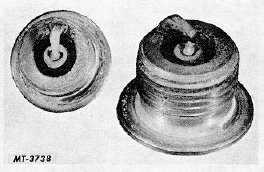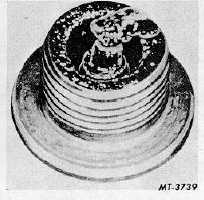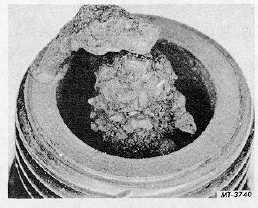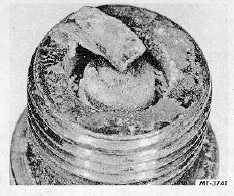|
| |
TRUCK SERVICE MANUAL
TM 5-4210-230-14&P-1
ELECTRICAL
Fig. 8 Effects of Turbulence Burning
Wet Fouling
Wet fouling,shown in Fig. 9, illustrates that the plug
has drowned in excess oil. In an old engine, suspect worn
rings or excessive cylinder wear. In OHV engines too much
oil may be coming in past the valve guides. Also, depending
on cylinder location, this fouling can suggest a leaking
vacuum booster pump diaphragm. Use of a hotter plug may
relieve such fouling, but plugs can't take the place of needed
engine overhaul. Remember that plug fouling in new engines
may occur before normal oil control is achieved. In new or
recently overhauled engines such fouled plugs can be cleaned
and reinstalled.
Fig. 9 Wet Fouling
Silica Deposits
Silica deposits, illustrated in Fig. 10, are hard and scratchy.
This material is largely lead silicate formed when fine sand
particles (silicate) combine with the anti-knock compounds in
the fuel. It's most common in trucks operating in dusty areas
or in sand loading operations. Such plugs cannot be cleaned.
Always check for intake manifold leaks and see that the air
cleaner on the engine is in good condition.
Fig. 10 Silica Deposits
Fuel Scavenger Deposits
Fuel scavenger deposits shown in Fig. 11 may be
white or yellow in color. They may appear to be bad, but this
is a normal appearance with certain brand fuels. Such
materials are designed to change the chemical nature of
deposits
to
lessen
misfire
tendencies.
Notice
that
accumulation on the ground electrode and shell areas may be
unusually heavy, but the material is easily flaked off. Such
plugs can be considered normal in condition and can be
cleaned with standard procedures.
Fig. 11 Fuel Scavenger Deposits
Sustained Preignition Damage
Sustained preignition damage, illustrated in Fig. 12,
usually involves melting of the ceramic firing tip. Since this
requires temperatures about 2700°F, other components of the
engine may also have been damaged by preignition. This is
another sure sign that a careful inspection of the engine and
its adjust ments is required.
CTS-2016-J Page 5
PRINTED IN UNITED STATES OF AMERICA
|




